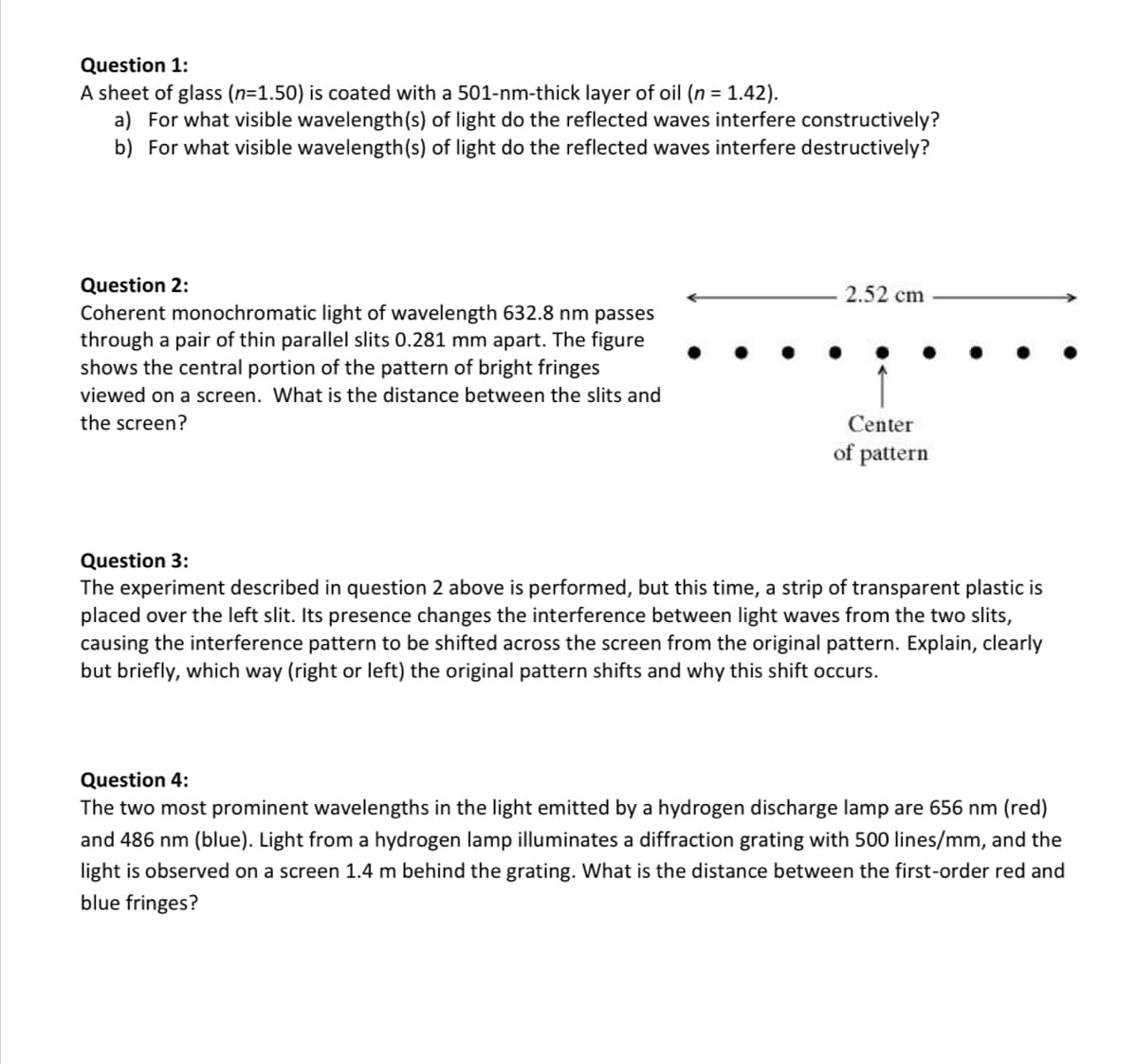Question 2: Coherent monochromatic light of wavelength 632.8 nm passes through a pair of thin parallel slits 0.281 mm apart. The figure shows the central portion of the pattern of bright fringes viewed on a screen. What is the distance between the slits and the screen? 2.52 cm Center of pattern
Question 2: Coherent monochromatic light of wavelength 632.8 nm passes through a pair of thin parallel slits 0.281 mm apart. The figure shows the central portion of the pattern of bright fringes viewed on a screen. What is the distance between the slits and the screen? 2.52 cm Center of pattern
Principles of Physics: A Calculus-Based Text
5th Edition
ISBN:9781133104261
Author:Raymond A. Serway, John W. Jewett
Publisher:Raymond A. Serway, John W. Jewett
Chapter27: Wave Optics
Section: Chapter Questions
Problem 14P: Coherent light rays of wavelength strike a pair of slits separated by distance d at an angle 1,...
Related questions
Question
Solutions to question 2 please

Transcribed Image Text:Question 1:
A sheet of glass (n=1.50) is coated with a 501-nm-thick layer of oil (n = 1.42).
a) For what visible wavelength(s) of light do the reflected waves interfere constructively?
b) For what visible wavelength(s) of light do the reflected waves interfere destructively?
Question 2:
Coherent monochromatic light of wavelength 632.8 nm passes
through a pair of thin parallel slits 0.281 mm apart. The figure
shows the central portion of the pattern of bright fringes
viewed on a screen. What is the distance between the slits and
the screen?
2.52 cm
Center
of pattern
Question 3:
The experiment described in question 2 above is performed, but this time, a strip of transparent plastic is
placed over the left slit. Its presence changes the interference between light waves from the two slits,
causing the interference pattern to be shifted across the screen from the original pattern. Explain, clearly
but briefly, which way (right or left) the original pattern shifts and why this shift occurs.
Question 4:
The two most prominent wavelengths in the light emitted by a hydrogen discharge lamp are 656 nm (red)
and 486 nm (blue). Light from a hydrogen lamp illuminates a diffraction grating with 500 lines/mm, and the
light is observed on a screen 1.4 m behind the grating. What is the distance between the first-order red and
blue fringes?
Expert Solution
This question has been solved!
Explore an expertly crafted, step-by-step solution for a thorough understanding of key concepts.
This is a popular solution!
Trending now
This is a popular solution!
Step by step
Solved in 3 steps with 3 images

Knowledge Booster
Learn more about
Need a deep-dive on the concept behind this application? Look no further. Learn more about this topic, physics and related others by exploring similar questions and additional content below.Recommended textbooks for you

Principles of Physics: A Calculus-Based Text
Physics
ISBN:
9781133104261
Author:
Raymond A. Serway, John W. Jewett
Publisher:
Cengage Learning

Physics for Scientists and Engineers with Modern …
Physics
ISBN:
9781337553292
Author:
Raymond A. Serway, John W. Jewett
Publisher:
Cengage Learning

Physics for Scientists and Engineers: Foundations…
Physics
ISBN:
9781133939146
Author:
Katz, Debora M.
Publisher:
Cengage Learning

Principles of Physics: A Calculus-Based Text
Physics
ISBN:
9781133104261
Author:
Raymond A. Serway, John W. Jewett
Publisher:
Cengage Learning

Physics for Scientists and Engineers with Modern …
Physics
ISBN:
9781337553292
Author:
Raymond A. Serway, John W. Jewett
Publisher:
Cengage Learning

Physics for Scientists and Engineers: Foundations…
Physics
ISBN:
9781133939146
Author:
Katz, Debora M.
Publisher:
Cengage Learning